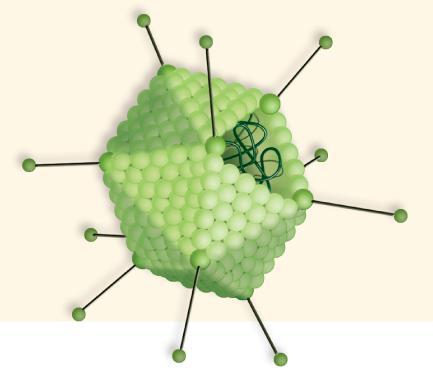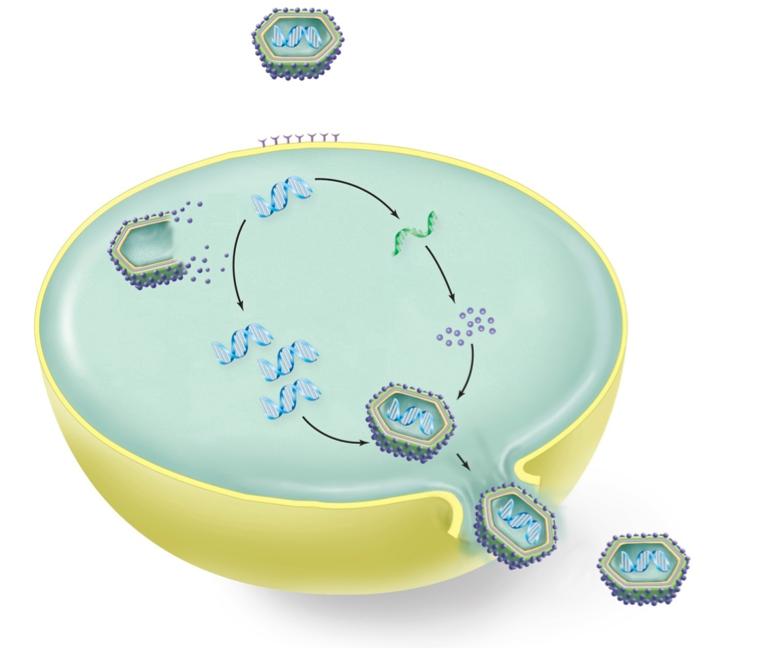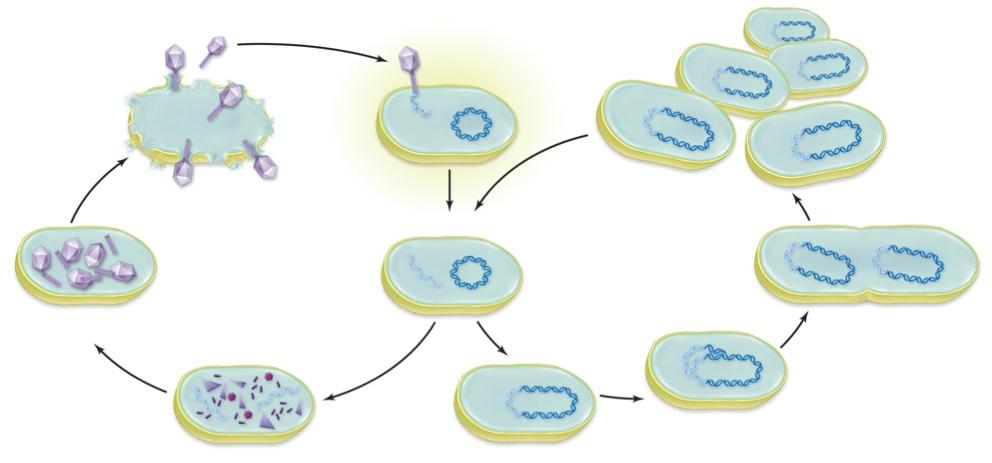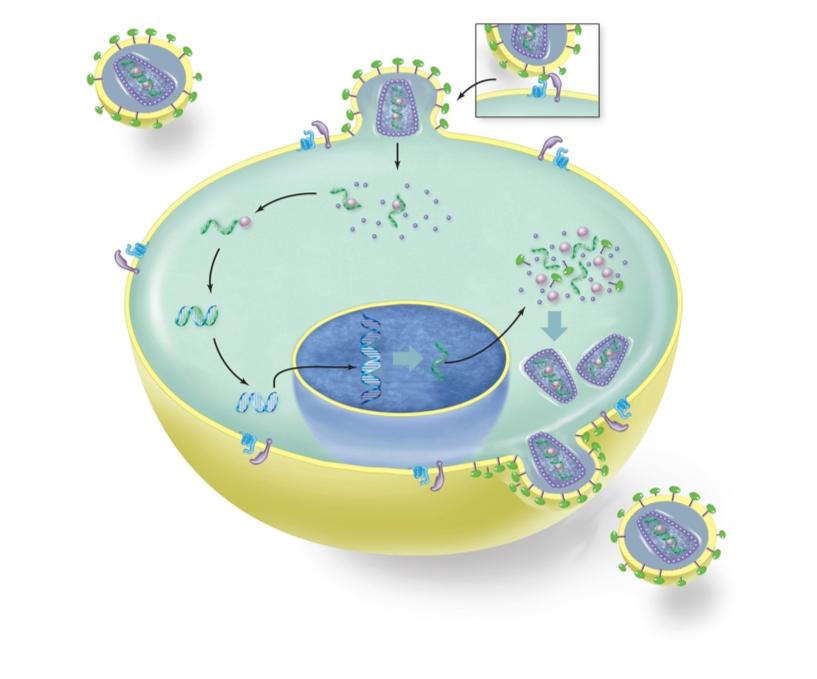Which of these is the best description of a virus?
- chemical complexes of RNA or DNA protected by a protein shell

1. Capsid (left)
2.fiber protein
3.fiber
4. RNA or DNA
5. Protein Unit
All of the following are diseases caused by viruses except
strep throat
Select the components present in all viruses. (Select all that apply).
- Ribosomes
- Protein coat
- Genetic material
- Phospholipid bilayer
- Cytoplasm

...
Arrange the steps in the order that they occur during viral infection and replication.
1. Attachment of virus to host cells.
2. Penetration of entire virus into host cell or injection of viral genome.
3.Synthesis of viral nucleic acid and proteins
4.Assembly of new viruses
5.Release of viruses from the host cell
Viruses reproduce by
- conjugation.
- exchanging gametes.
- exchanging ge nes.
- using the metabolic machinery of the host cell
- binary fission.
Phages are viruses that can infect
- humans.
- plants.
- insects.
- farm animals.
- bacteria.

...
What is similar between the lysogenic cycle of a bacterial virus and the HIV infection cycle?
- Reverse transcriptase makes a DNA copy of the virus RNA.
- Only the genetic material of the virus enters the host cell.
- The viral genome is integrated into the host chromosome.
- New virus particles bud out of the cell without killing the cell.
Complete the following sentences to describe the stages of the lytic cycle of viruses. Then, place the stages in chronological order for full credit.
1.During the attachment stage, the capsid of a virus combines with receptors on the host cell's plasma membrane.
2.During the biosynthesis stage, enzymes digest cell wall and membrane material so that viral nucleic acids can enter into the host cell.
3.During the penetration stage, viral nucleic acids and capsid components are produced.
4.During the maturation stage, viral nucleic acids and capsid components are assembled to produce viral particles.
5.During the release stage, lysozyme enzyme is produced, rupturing the cell membrane and releasing viral particles.
Infection with HIV viruses causes the death of immune system cells called ______, and over many years, HIV can lead to a disease called ______ in which the immune system is deficient.
- erythryocytes; Hepatitis B
- helper T cells; AIDS
- lymph nodes; influenza
- cold sores; Herpes Simplex I

...
Arrange the steps in the order that they occur during HIV infection and replication.
...
Which statement is NOT true about retroviruses?
- HIV is a retrovirus.
- They contain an enzyme called reverse transcriptase.
- They incorporate themselves into the host cell genome, but replicate independently of the host DNA.
What are zoonotic diseases?
- diseases that are commonly found in animals residing in zoos
- diseases normally found in animals, which have somehow jumped to people
- diseases that result from being bitten by infected animals
- diseases caused by bacteria found in the tropical rainforests
Human Immunodeficiency Virus (HIV) presently infects about 40 million people worldwide. In what organisms did HIV originate?
- from coldwater game fish in the ocean
- from birds in Asia
- from mosquitoes in the Nile swamplands
- from monkeys in the rain forests
Which of the following would be classified as a zoonotic disease?
- A rash appears on a camper in response to a plant toxin.
- A diver suffers cardiac arrest from toxins delivered in a jellyfish sting.
- A hunter develops a fever two days after skinning rabbits.
- A hiker suffers tissue death resulting from snake bite venom.
What are the two prokaryotic domains?
- Archaea & Bacteria
- Eukarya & Bacteria
- Archaea & Eukarya
- Protista & Archaea
Complete the following paragraph to describe the components of bacterial cells.
Prokaryotes are surrounded by a cell envelope that contains the plasma membrane to regulate the entry and exit of materials through the cell, the cell wall to help maintain cell shape and structure, and the glycocalyx (when present) to aid in attachment and evasion.
The DNA of a prokaryote is arranged in a single coiled chromosome located in the nucleoid.
Some prokaryotes carry genes on extrachromosomal pieces of circular DNA called plasmids.
Embedded within the cytoplasm are small particles called ribosomes that function in protein synthesis.
Some prokaryotes, such as cyanobacteria are photosynthetic and contain thylokoids to aid in photosynthesis.
Binary fission is a form of sexual reproduction in which the daughter cells have a different genetic combination than the parent cell.
True
False
Bacteriophages carry portions of bacterial DNA from one cell to another in a process called
- transformation.
- t ransduction.
- conjugation.
- infection.
- replication.
Bacterial cells pick up free pieces of DNA that were secreted by live bacteria or released from dead bacteria in their environment. This process is called
- transformation
- transduction.
- conjugation.
- infection.
- replication.
When conditions are unfavorable, some bacteria form
- pili.
- endospores
- galls.
- capsules.
- thylakoids.
Which of the following is a mismatch for the environment in which Archaean lives?
- thermoacidophiles - live in extremely acidic environments with cooler temperatures
- methanogens - prefer anaerobic environments
- halophiles - live in high salt environments